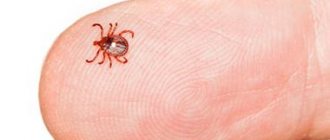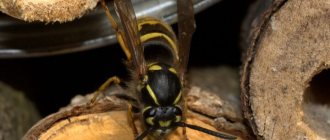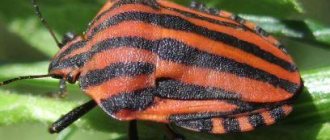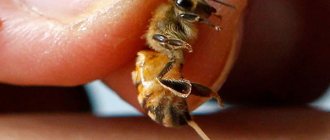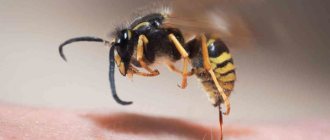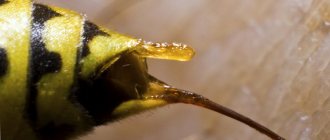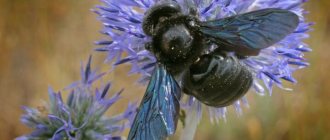Composition of bee venom
Bee venom is produced by the secretion of glands in honey bees. The substance has a liquid, slightly yellow consistency, with a pungent aroma and bitter taste.
Before you find out the benefits and harms of bee stings, you should familiarize yourself with its chemical composition. All components of apitoxin have individual characteristics, while simultaneously enhancing its overall effect. The main elements of bee venom are:
- melitin – has powerful antibacterial, antiviral, anti-inflammatory properties, as well as nonspecific cytotoxicity and hemolytic properties;
- apamin – a substance with a neurotropic effect, increases the activity of nerve receptors;
- histamine is an organic compound that provokes the development of an allergic reaction, a regulator of important physiological processes in the body;
- hyaluronidases - a group of enzymes that increase tissue permeability and prevent the proliferation of cancer cells;
- phospholipase – helps accelerate the hydrolysis of phospholipids.
Bee venom contains some beneficial chemicals. Among them:
- magnesium;
- formic acid;
- phosphorus;
- carbohydrates;
- sulfur;
- proteins;
- polypeptides.
About the benefits of a bee sting
A bee sting can not only cause harm, even death, but also help in the treatment of diseases.
Bee venom contains amino acids (up to 90% of their composition is in demand in the human body) and protein substances; consists of phosphorus and magnesium, calcium and copper, carbon and hydrogen, phospholipids and glucose. All components actively affect the human body:
- Hydrochloric and formic acids can dilate blood vessels and lower blood pressure.
- Peptides ensure the activity of hormonal, protein, fat, mineral and water metabolic processes in the body, thereby providing an invaluable contribution to health.
- The enzyme protein, on the contrary, stimulates a person’s sensitivity to the composition of the poison and poses a threat to allergy sufferers due to the consequences of anaphylactic shock or Quincke’s edema.
What are the benefits of a bee sting?
Medical scientists confirm that the benefits of bee venom for humans are quite great. The substance is distinguished by its specific healing properties. These include:
- restoration of tissue structures of bones;
- normalization of heart rate;
- analgesic, antispasmodic, antiviral effect;
- increasing the amount of serotonin;
- beneficial effects on blood vessels, lowering cholesterol levels;
- blood purification;
- improving the functioning of the digestive system;
- getting rid of pathogenic microbes;
- activation of the body's immune forces.
Important! Despite its wide spectrum of action, the beneficial properties of apitoxin have not been fully studied. Thanks to the developments of modern scientists, doctors have high hopes for expanding the healing properties of bee venom in the treatment of serious diseases, including cancer.
Harm from a bee sting
The medicinal benefits of a bee sting for humans are an indisputable fact. Despite this, there is a risk of harm to health of varying degrees of severity. In a single case of a single bee sting, a local reaction occurs, characterized by the occurrence of severe pain and a burning sensation. If an allergy to the secreted poison in a weak form is added to the usual symptoms, urticaria appears on the affected area of the skin, accompanied by itching and blisters.
A reaction to a bee sting can most likely provoke Quincke's edema, in which swelling spreads to the face, neck, as well as the eyelids, tongue, and larynx. The condition is aggravated by the accompaniment of various negative symptoms. Among them:
- hoarseness of voice;
- dry, barking cough;
- feeling of suffocation;
- breathing problems;
- nausea, vomiting;
- severe abdominal cramps;
- hypoxic coma;
- death.
An equally health and life-threatening complication of a bee sting is the onset of anaphylactic shock. In this case, there is an acute decrease in blood circulation, a sharp drop in blood pressure, collapse, and fainting.
Important! An allergic reaction develops rapidly and poses a mortal danger to humans.
Treating bee stings at home
Treating bee stings at home
Recently, many people are beginning to pay great attention to natural medicines. An interesting trend has emerged to treat many diseases in an unconventional way. This explains the increased interest in bee therapy and what this direction is called.
According to medical terminology, therapeutic therapy with bee stings is called “apitherapy.” This word comes from the Latin “apis” - bee and means the use of bee products for medicinal purposes.
To carry out treatment at home, it is advisable to obtain a medical consultation, as a result of which the indications for the use of this procedure will be determined. If no contraindications are identified, then treatment with bee stings should begin gradually, starting from two to three stings. If this procedure is well tolerated, then you can gradually increase the number of “bee pricks” in each subsequent session.
Delicious recipe! How to prepare for Halloween
Important! Bee therapy will be effective if the bees bite at certain biologically active points of the human body.
Before you begin treatment for bee stings, you need to determine your reaction to a sting. For this purpose, an insect is placed on the lumbar region for a few seconds, and it sticks its sting into the human body. After the initial procedure, it is necessary to take blood and urine tests to find out if there are any disruptions in vital functions. If there are no allergies or side effects, the “bee pricking” procedure is repeated, increasing the time the sting is present to 1 minute. After these trial “injections” you can begin treatment.
There are several subtleties of bee therapy:
- Bee stings should be placed on different points of the body every day.
- Two weeks after the start of treatment, it is necessary to take a break, then the bites are resumed again and their number is increased three times.
- The procedure begins by cleaning the application site with water and soap.
- The bee's belly is applied with tweezers to bite the target point for several minutes, then the sting is pulled out and the bite site is treated with boric petroleum jelly or an aqueous solution of hydrogen peroxide.
- Due to the temporary rush of blood to the wound after the procedure, it is recommended to lie down for at least half an hour.
For apitherapy to be successful, it is necessary to avoid heavy physical activity, alcohol consumption and adhere to a healthy lifestyle during treatment.
Note! For the treatment of children and the elderly, the dosage of bee stings should be carefully selected. Bee therapy has a strong healing effect on this category.
Signs of a bee sting
A bee sting is characterized by a specific process with an immediate response from the body of the injured person. There are certain signs:
- a released sting that digs into the skin with the help of barbs;
- redness and swelling of the affected area of the body;
- sudden severe pain at the point of the bite;
- severe swelling;
- manifestations of an allergic reaction to varying degrees;
- The insect that releases its sting dies.
Unpleasant symptoms subside after the bee sting is removed from the body, and the effect of the poison continues for some time.
First aid for a bee sting victim
A bee sting requires the immediate implementation of a number of specific actions:
- remove the sting from the victim’s skin as quickly as possible, since the poisonous substance enters the blood from it;
- treat with an antiseptic;
- apply ice or a cold compress;
- to relieve swelling, use anti-inflammatory hormonal ointments;
- to avoid increasing the toxic effect, do not drink hot drinks;
- take antihistamines.
If a severe allergic reaction to a bee sting occurs, it is recommended to immediately call an ambulance and, before it arrives, give an intramuscular injection of dexamethasone.
How to Avoid a Bee Sting
For those who are not a supporter of apitherapy and do not want to become a victim of bee venom, you need to adhere to the basic rules:
- remain calm when meeting an insect and do not wave your arms,
- You should not eat foods on the street that attract bees: fruits and sweets,
- if you are going to relax in nature, then it is better to dress discreetly, cover your arms, legs and head,
- insects seen nearby should not be disturbed.
In general, an encounter with a bee can bring not only harm, but also tangible health benefits. The most important thing is to know how to remove the swelling that occurs from a bee sting and prevent the development of complications. It is even more important to remember what to do if you are allergic to a bee sting. A person’s life may depend on correctly provided first aid.
Folk remedies for bee stings
In the absence of pronounced manifestations of allergies due to a bee sting, various folk remedies with beneficial properties are successfully used to alleviate negative symptoms. Among them:
We recommend reading: Baking soda: beneficial properties, uses, how to take
- olive oil;
- solutions of soda, manganese, activated carbon, vinegar, alcohol;
- aloe leaves;
- onion or garlic juice;
We recommend reading: The benefits and harms of leeks
- parsley;
- decoctions of medicinal herbs;
- fresh plantain leaves, cabbage.
Recommended reading: Benefits of white cabbage, properties and preparation
Any of the listed herbal beneficial remedies is applied to the affected area of the body with a poisonous sting, periodically repeating the procedure. It is recommended to wipe the sites of bee stings with disinfecting anti-inflammatory solutions or use them as lotions.
Bee sting allergy
The benefits and harm to the body from bee venom have unclear boundaries. This is due to the fact that a bee sting can provoke the formation of an allergic reaction to the substance secreted by the insect. There is a rapid development of unfavorable and life-threatening signs, which include:
- severe swelling of the mucous membranes and respiratory organs;
- development of bronchospasm;
- tachycardia;
- redness or paleness of the skin, nettle rash;
- nausea, vomiting;
- a sharp change in blood pressure;
- feeling of lack of air;
- pressing pain in the heart;
- convulsions;
- fainting.
The speed of development of an allergic reaction to a bee sting depends on the individual characteristics of the body, but mainly manifests itself during the first minutes after the sting and can cause harm. The condition requires an immediate response to the problem, rapid manipulation to relieve dangerous symptoms.
Symptoms
The appearance of signs characteristic of a bee sting after the skin is damaged by the sting may take from a few seconds to several hours. The following symptoms are noted:
- acute pain;
- burning sensation;
- swelling and redness around the wound.
Attention! The area where the bee sting is located is of great importance. Swelling of the skin in the eye and lip area decreases only after 7-10 days; in other areas of the body, swelling subsides within 3-48 hours.
What to do
In case of an unexpected bee sting, you should act quickly, but under no circumstances panic. The development of complications and consequences in the future depends on the correctness and timeliness of the actions taken.
Immediately after removing the sting, it is necessary to treat the affected area of the body with any antiseptic and apply ice or a cold bandage. If possible, use an antihistamine for external use. This will help relieve swelling and reduce the feeling of burning and itching.
If allergic symptoms to a bite occur, it is recommended to immediately call an ambulance, which, depending on the patient’s condition, will use drugs to relieve spasms, swelling, inflammation, or administer adrenaline in more severe cases.
First aid and treatment
Help with a bee sting should be carried out in the following order.
Removing the sting
After a bee sting, you must carefully remove the sting (without touching the sac of poison) remaining in the skin. It's best to use tweezers here. You must first treat the instrument with alcohol or a disinfectant.
Neutralize the poison with a soap solution. Why soap solution? Bee venom has an acidic pH, so it can be neutralized with an alkaline solution, in this case soap.
Disinfection
Treat the arm, leg, or other bite site with hydrogen peroxide, a solution of ammonia (it can also relieve swelling) or potassium permanganate, or alcohol tincture of calendula.
To relieve pain, use a cold compress (ice wrapped in a towel, for example). There is great benefit from medications and ointments with an antihistamine effect. For example, “Suprastin”, “Diphenhydramine”, “Fenistil”, etc. They can relieve symptoms.
- Aspirin and activated carbon are excellent absorbents of various poisons. When combined with aspirin, it can treat pain and itching. Dissolve one tablet in a glass of water and apply cotton wool soaked in this solution to the desired location.
- Parsley – this plant produces a good anti-inflammatory effect and is beneficial. Apply parsley leaves brewed in boiling water or crushed to the stung hand, leg, etc. The plant treats redness, swelling and pain. You can add plantain leaves to parsley, which help speed up wound healing.
- Olive oil – can relieve redness and irritation. Unsaturated fatty acids in the oil have a regenerating and nourishing effect on the skin.
- Onion juice contains substances that bind the components of bee venom. Helps relieve pain, redness and reduce swelling.
- Aloe – has numerous medicinal properties. The diluted juice of the plant is used as a compress. Aloe treats itching, hives, swelling.
Never apply soil when bitten, as traditional medicine advises! This will not relieve pain and may lead to infection.
Treatment for a bee sting begins with the mandatory removal of the sharp sting. If you leave it in the wound, the pain only intensifies and the amount of poison in the body increases. To do this, use ordinary tweezers, which are first wiped with alcohol or an antiseptic solution. In “camping” conditions, you can use a sewing needle or the edge of a plastic card.
After carefully removing the sting, apply a cold compress or piece of ice wrapped in a clean cloth to the reddened area. You can wipe the wound with hydrogen peroxide, a solution of Chlorhexidine or Miramistin. If necessary, antiseptics are replaced with iodine diluted in water with Furacilin or baking soda.
We invite you to read: Garlic – beneficial properties, composition and contraindications
First aid for a bee sting is to use antihistamines. A person needs to take a tablet of Suprastin, Tavegil or Diazolin, dilute 15–20 drops of Zodak in a glass of water. You should calm down, go to a cool place, drink iced tea. Hot drinks only increase blood circulation and increase the absorption of toxins. The pharmacy offers special ointments containing lidocaine, components that relieve itching: Fenistil, Psilo Balm, Advantan.
Living in rural areas, you should know what to do if you are stung by a bee and there is an increased risk of an allergic reaction. Before the medical team arrives, it is necessary to cover the victim or warm him up if he has a chill, give him a drink with the addition of a few drops of Valoserdin and peppermint tincture. In case of loss of consciousness, use ammonia and rub the temples with light massage movements.
Using these tips, you can help a small child with a bee sting. After removing the hard sting and treating the inflamed area, he should be distracted with a toy or cartoons, and given an antiallergic drug: Zodak, Claritin, Loratadine. To relieve pain, you can give children's Panadol or Nurofen.
You must not be at a loss to understand what to do if a bee bites a person in the eye or head. Thin skin swells within a few minutes, and visual acuity may be affected. In addition to the standard cold compress, a paste of acetylsalicylic acid and activated carbon is applied to the face. Several tablets of each drug are ground into powder by adding a spoonful of water. After rinsing, apply ointment with prednisolone to the eyelid and wash with chamomile decoction.
An allergic reaction sometimes appears within 15–30 minutes. Therefore, it is important to see a doctor as soon as possible. He will tell you what to do when bitten by a bee, what medications to use urgently. In case of severe convulsions and suspected angioedema, the following measures are carried out in a hospital setting:
- The patient is placed in a supine position with the head elevated above the chest.
- An adrenaline solution is injected into a vein to normalize the heart rate.
- Antihistamines are used in conjunction with the hormone prednisolone to dilate the bronchi and relieve spasms.
- Antishock therapy with diuretic diuretics is carried out, aimed at removing the toxin and stabilizing the patient's condition.
A patient with swelling and allergies is left under the supervision of a doctor for 2–3 days. The specialist needs to make sure that the consequences are eliminated. The patient is advised to visit an allergist and carry antihistamines with him at all times.
Anyone can get hurt, so everyone should know what to do if they get stung by a bee. The algorithm of actions is very simple.
- Remove the sting, as the bee always leaves it at the site of the bite. This is necessary in order to stop further entry of poison into the body. This must be done very carefully using tweezers, which should first be treated with an alcohol-containing solution. If tweezers are not at hand, you can try to remove the sting with your fingernails or using a disinfected needle.
- The bite site must be treated. Can be washed with soap and water or a weak solution of potassium permanganate. Any antiseptic will do, for example, alcohol, calendula setting.
- A simple way to relieve swelling after a bee sting is to apply a cloth soaked in cold water. Ice will do too. Do not use water from a nearby reservoir for these purposes - you can get infected.
- Take an antihistamine tablet. You can take Suprastin, Tavegil, Cetrin, Zodak. It is better to give the medicine in the form of drops to children.
- Ointments and creams such as Advantan, Fenistil Gel, and hydrocortisone ointment are used locally.
- Drink more liquid, then the poison will be eliminated from the body faster.
The bite site should not be scratched. Alcohol should be avoided as it promotes the rapid spread of poison in the body. If everything is done correctly, the swelling goes away without a trace within 1–5 days.
Use of bee venom in medicine
Apitoxin is effectively used in medical practice to treat many diseases. The benefits of bee venom for joints are invaluable. The substance is actively used for diseases of the musculoskeletal system and nervous system, serving as the main ingredient in a number of medicines. Ointments, creams, gels containing it have the following beneficial properties:
- resumption of joint activity;
- pain relief;
- reduction of swelling;
- antirheumatic, anti-inflammatory, bactericidal effect;
- normalizing metabolism.
What diseases are treated with bee stings?
The following common diseases are cured by bee stinging.
Central nervous system disease
Improving blood circulation after a bee sting restores the functioning of the nervous system. A person’s coordination of movements improves, a sense of physical strength appears, and the reaction stabilizes. If there are diseases of the central nervous system, then their symptoms become milder and sometimes disappear altogether. There is a method of bee stinging, the scheme of which was developed by N. Ioirish. It is aimed at treating the central nervous system, relieving pain syndromes, and maintaining immunity. It is used during rehabilitation after a stroke to activate the functioning of the adrenal glands. For the initial course, the use of 55 bees is provided. After a four-day break, three insects sting every day for 1.5 months. The general course of treatment takes place using 200 bees.
Spine treatment
Bee stinging is the first remedy for spinal diseases. This includes arthrosis and osteochondrosis. Bites help well with vertebral hernia. In order for the sting to help, the procedure must be performed only by a specialist. The doctor identifies active points in the spine and directs the bee sting there. The poison penetrating into the blood helps reduce pain syndromes. The patient feels its warming and antispasmodic effect. For radiculitis, the course of stinging lasts 2 times a week for 1.5 months. After a two-month break, bee stinging is carried out daily.
Treatment of varicose veins
For varicose veins, bee sting treatment has no analogues. The fact is that poison cannot be artificially synthesized. Other medicines cannot surpass its effect. Stinging accelerates blood circulation, causing blood vessels to dilate. The vein valves resume their function, reducing the risk of blood clots. The poison has a positive effect on blood clotting and strengthens the walls of blood vessels. In combination with bee stinging, a daily intake of honey is usually prescribed, at least 1 tbsp. l. Apitherapy is carried out by a specialized doctor who can accurately determine the active points on the patient’s body for a bee sting.
When prescribing a course of treatment, the doctor takes into account the client’s condition and selects bees based on age, because each insect has a different composition of venom.
The benefits of a bee sting can only be obtained using a developed medical method. Self-medication by stinging at random will be useless, and sometimes it can result in allergies or other problems.
Treatment with bee venom
When treated with bees, the harm and benefit to human health is based on the characteristics of the body’s condition and the presence or absence of an allergy to insect venom.
Apitherapy has long been successfully used in the development of various pathologies, such as:
- rheumatism;
- arthritis;
- vascular diseases;
- trophic ulcers;
- inflammation of peripheral nerves;
- migraine;
- infections;
- furunculosis;
- skin diseases;
- allergy;
- pathologies of the visual organs.
Each type of disease has its own treatment options for bees; the number of bees used and the duration of exposure to apitoxin usually ranges from 4 to 10 minutes.
Important! Before starting treatment with bee stings, it is recommended to test for allergies to the venom.
Bee venom in cosmetology
The scope of bee venom extends beyond medicine. The substance also brings great benefits in the field of cosmetology and is widely used as an effective skin care product. The main properties of bee venom are:
- hydration;
- enrichment with useful substances;
- strengthening blood vessels;
- protection against inflammation.
Due to the use of cosmetic products based on bee venom, the skin acquires the effect of firmness, firmness and elasticity.
